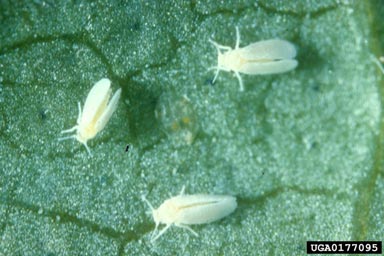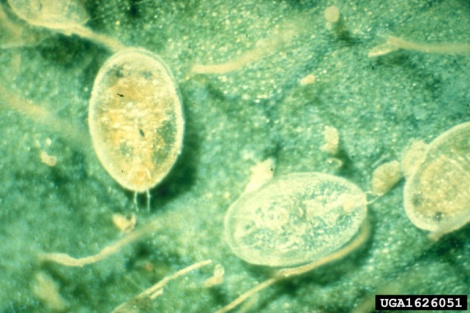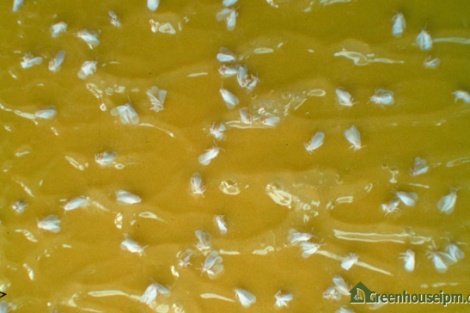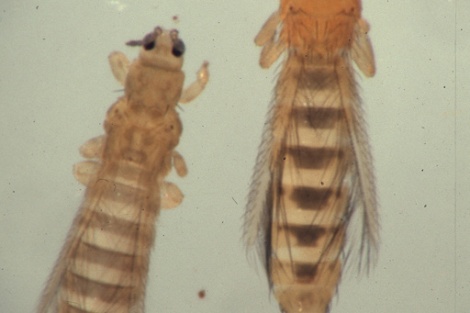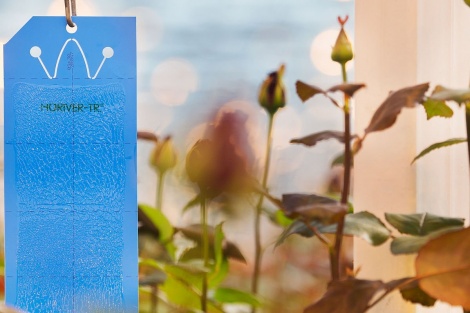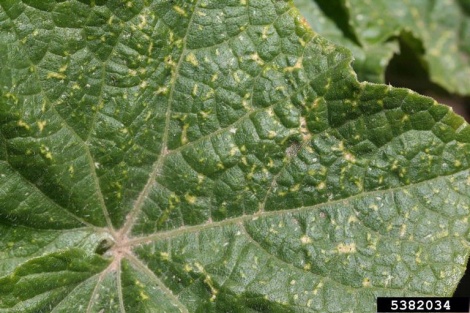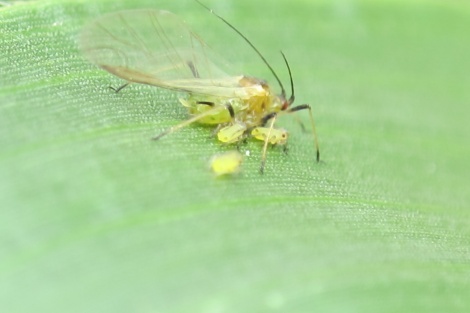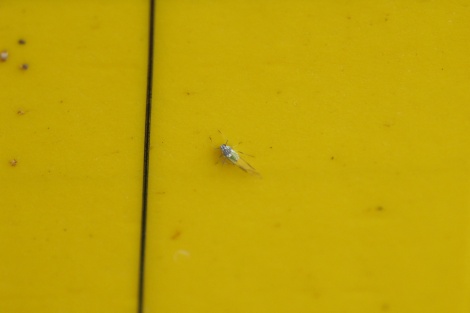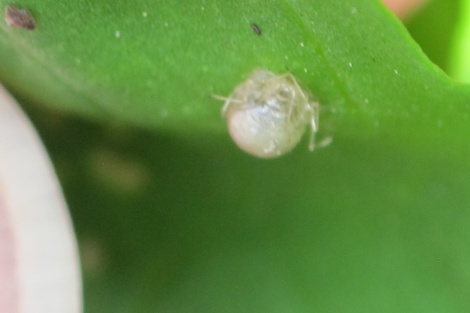In this issue:
- Whiteflies
- Thrips
- Aphids
Whiteflies in the Greenhouse
Monitoring
Whiteflies may successfully overwinter inside Utah’s heated greenhouses. The two most common species observed are the silverleaf whitefly (Bemisia argentifolii) and the greenhouse whitefly (Trialeurodes vaporariorum). Adult whiteflies measure 1-2 mm long and have a pair of hind and fore wings. Whiteflies are triangular-shaped, with their distal portion of the wings wider than the basal section. Nymphs are translucent, flat, and immobile. Frequently monitor for whiteflies amongst vegetable transplant production. Visually inspect for nymphs, pupae, and adults on the undersides of leaves. Hang yellow sticky traps near susceptible plants to observe population thresholds.
Damage
Adults and immobile nymphs have piercing-sucking mouthparts that suck sap from the plant’s phloem in the stem and leaves. Large populations can cause foliage to turn yellow, dry, and eventually drop. Large groups of adult whiteflies excrete honeydew which causes the leaves to stick and potentially become covered in a black, sooty mold that grows on the honeydew. Most greenhouse plants are susceptible to whiteflies.
Management
Cultural
- If greenhouse production allows, plan for periods of host-free production. The continuous culture of plants allows whiteflies to move from older to younger plants.
- Keep the greenhouse space weed-free. Weeds can be a “bridge” for whiteflies during crop-free periods.
- Yellow sticky traps primarily serve as a monitoring tool but can help reduce whitefly densities.
Biological
- Parasitic wasps such as Encarsia formosa and Eretmocerus eremicus can be purchased via parasitized whitefly pupae to release in the greenhouse.
- The predatory mite Ambylseius swirskii feeds on whitefly nymphs and eggs. They may consume up to 20 whitefly eggs/nymphs a day. They can be purchased as nymphs and adults in shaker bottles or continuous slow-release paper sachets.
- The predatory beetle Delphastus catalinae preys on whitefly eggs and nymphs. They may be purchased in shaker bottles.
Chemical
- Azera® Insecticide (Active Ingredients: pyrethrin + azadirachtin), registered for commercial greenhouse use in Utah.
- Admire® Pro Systemic Protectant (Active Ingredient: imidacloprid), registered for commercial greenhouse use in Utah.
- Safer® Brand Insect Killing Soap (Active Ingredient: potassium salts of fatty acids), an organic option available for home use.
- BotaniGard® ES (Active Ingredient: Beausveria bassiana (GHA strain)), an organic option available for home use.
Thrips in the Greenhouse
Monitoring
Thrips species common to Utah greenhouses include the western flower thrips (Frankiniella occidentalis) and onion thrips (Thrips tabaci). Adults are small and slender (2mm long). They’re shades of brown and have fringed wings. Monitor by hanging yellow or blue sticky card traps early after seeding. Visually inspect cards weekly along with identifying signs and symptoms on plants.
Damage
Thrips have a wide range of hosts in vegetables. They feed by scraping plant cells using their piercing-sucking mouthparts to extract juices. This leaves the plant tissue with bleached-looking spots with a silvery appearance. Thrips also leave black frass at their feeding sites. Thrips may vector viruses such as the impatiens necrotic spot virus and tomato spotted wilt virus. Most greenhouse plants are susceptible to thrips.
Management
Cultural
- Clear greenhouse of any weeds, as they can serve as alternate hosts for both thrips and viral disease.
Biological
- Minute Pirate Bugs (Orius ) are generalist predators that feed on adult thrips. They take up to 8 weeks to become established and effective. Consider releasing prior to severe infestations. It can be purchased as shaker bottles.
Chemical
- Decathlon® 20 WP (Active Ingredient: cyfluthrin), registered for commercial greenhouse use in Utah.
- PyGanic Crop Protection EC 1.4 II (Active Ingredient: pyrethrins), registered for organic commercial greenhouse use in Utah.
- Entrust® (Active Ingredient: spinosad), registered for organic commercial greenhouse use in Utah.
- Safer® Brand Insect Killing Soap (Active Ingredient: potassium salts of fatty acids), an organic option available for home use.
- BotaniGard® ES (Active Ingredient: Beausveria bassiana (GHA strain)), an organic option available for home use.
Aphids in the Greenhouse
Monitoring
Various species of aphids are pear-shaped and have soft bodies. They have two “tail pipes” on the end of their abdomen called cornicles. Adults may develop wings if populations become overcrowded. Monitor by visually inspecting the underside of plant foliage. Look for excretion of honeydew which indicates large populations. Greenhouse operations should set their own thresholds.
Damage
Aphids use their stylet-like mouthparts to suck out sap from the plant’s phloem. This may cause stunted growth, plant distortion, leaf curling, and yellowing. Excreted honeydew may serve as a substrate for sooty mold growth. Aphids have the potential to spread viral diseases. Most greenhouse plants are susceptible to various species of aphids.
Management
Cultural
- Clear greenhouse of any weeds, as they can serve as alternate hosts for both aphids and viral disease.
- If greenhouse production allows, allow periods of host-free production. The continuous culture of plants allows aphids to move from older to younger plants.
Biological
- Parasitic wasps (Aphidisu colemani, Aphidius ervi, and Aphidius abdominalis) can be purchased in vials containing newly emerged adults or parasitized aphid mummies.
- Green Lacewings larvae (Chrysoperla rufilbris) use their mandibles to attack aphids. Green lacewings can be purchased as eggs, larvae, or adults to be released in the greenhouse.
- Convergent lady beetles (Hippodamia congergens) adults and larvae consume several aphids in their lifetime. They can be purchased and released into the greenhouse.
Chemical
- Aza-Direct® Botanical Insecticide (Active Ingredient: azadirachtin), registered for organic commercial greenhouse use in Utah.
- Bonide® All Seasons Horticultural & Dormant Spray Oil Concentrate (Active Ingredient: mineral oil), an organic option available for home use.
- Safer® Brand Neem Oil Concentrate (Active Ingredient: extract neem oil), an organic option available for home use.
- Safer® Brand Insect Killing Soap (Active Ingredient: potassium salts of fatty acids), an organic option available for home use.
Note: All brands are registered trademarks. The brands listed in this table are not all-inclusive but are meant to provide examples of products for these crops in Utah. Always check the label for the specific crop you are treating, application and safety information, and protection and pre-harvest intervals.

